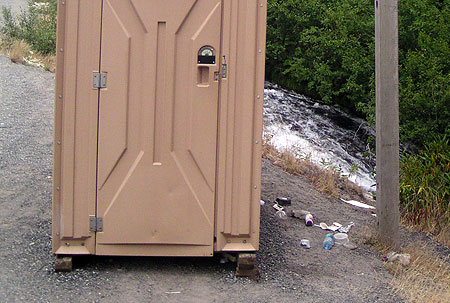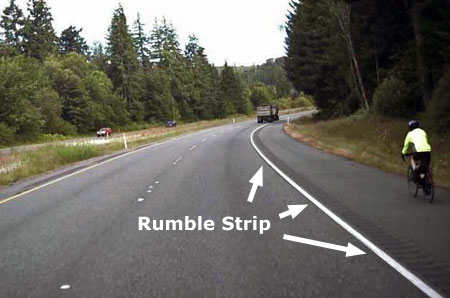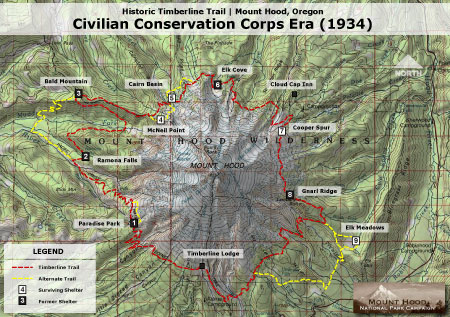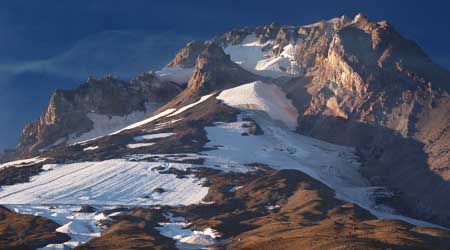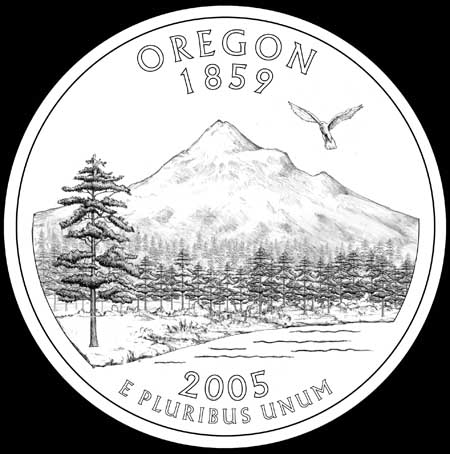
The year is 2035, and a family of tourists is just arriving at a local bed and breakfast in the village of Brightwood, Oregon, along the old Mount Hood Loop highway. They have just traveled 45 miles from Portland International Airport to Brightwood on the first of a six-day, world-class cycling tour of Mount Hood and the Columbia River Gorge.
On the first day of their tour they followed quiet country roads through the beautiful farms and picturesque pastures of the lower Sandy River Valley. Mount Hood floated on the horizon for much of their ride, hinting at the sights to come. After a night in Brightwood, the family will continue on to the village of Rhododendron, where the newly completed Historic Mount Hood Loop (HMHL) State Trail begins a spectacular tour of some of Oregon’s finest scenery.

Inspired by the recently completed Historic Columbia River Highway (HCRH) State Trail, this new trail follows once forgotten or abandoned segments of the historic Mount Hood Loop highway, with new connecting segments completing the route through mossy rainforests, alpine meadows and along mountain streams. Most of the new trail is far from the traffic, noise and hazards of the modern highway corridor, taking visitors back in time and pace of what it was like to experience the original loop highway more than a century ago.
A few miles up the new route, at the Little Zigzag River, the family parks their bikes for a short hike to a shady waterfall. Next, they will climb Laurel Hill along restored sections of the original highway, where route passes the nearly 200-year old ruts from covered wagons on the Oregon Trail that can still be seen. Their next stop is in Government Camp for lunch, with a visit to the Mount Hood Cultural Center and Museum.

From Government Camp, their tour descends past Summit Meadows to iconic Trillium Lake, then heads east to the White River and Hood River Meadows. At Sherwood Campground they reach the east end of the new HMHL State Trail, and park their bicycles for the night. Here, they will stay in one of the well-stocked Forest Service yurts that overlook the East Fork Hood River. After a light dinner, the family hikes the easy trail to nearby Tamanawas Falls to cap a specular day on the mountain.
On their third day, the family begins a scenic descent along the Mount Hood Loop into the orchards of the Hood River Valley, stopping in the village of Parkdale for lunch and at roadside fruit stands along the way. They arrive in the town of Hood River by late afternoon, with plenty of time to explore the town’s galleries, shops and restaurants before checking in to the historic Hood River Hotel for the third night of their tour.

From Hood River, the family spends their fourth day on the spectacular, world-famous HCRH State Trail, traveling west through the newly restored Mitchell Point Tunnel and a stop at the short, new viewpoint hike to Viento Bluffs. A bicycle-friendly hotel in Cascade Locks serves as their base for a longer, late afternoon hike along the scenic Pacific Crest Trail.
On the fifth day of their circuit, the family continues their tour on the HCRH State Trail from Cascade Locks to the west trailhead at Ainsworth State Park, where they follow the Historic Columbia River Highway west to Multnomah Falls for lunch and another short hike to the iconic Benson Bridge. Finally, they make the climb past Crown Point and then down to their final night at a Troutdale bed and breakfast, located along the Sandy River.
From Troutdale, the family will return to PDX and a flight home after their memorable six-day, 155-mile journey along the old Mount Hood Loop — no car required!
________________
In this two-part article, we’ll explore some long-forgotten sections of the old Mount Hood Loop highway, and the potential for bringing them back to life in the same way that abandoned sections of the old Columbia River Highway have been reclaimed. But does restoring the historic Mount Hood Loop Highway as a state trail make sense?
Yes, if you consider that bicycle tourism contributes $83 billion annually to U.S. economy, according to a 2017 study by the Outdoor Industry Association. Or that bicycle tourism in Oregon brings more than $400 million to our state economy, according to a 2012 study by Travel Oregon. And studies also show that touring cyclists tend to be older, wealthier and spend more when they travel, making them a coveted market in tourism.

Most importantly, these tourists don’t speed home after a day on the mountain to spend their money back in Portland. Instead, they invest in the local tourism economy along their multi-day tours, supporting the local lodging, restaurants, guides, museums and galleries that rely on tourist dollars to survive.
This article opened with a story about a future family traveling the 155-mile Mount Hood Loop over six days, but more ambitious riders could easily complete the loop in two or three days. Visitors with more time could easily spend a week or more exploring side trails and the towns along the loop, including a visit to historic Timberline Lodge.

The nearly completed HCRH State Trail has also shown that local cyclists and walkers use the route in day-segments, taking advantage of the many trailheads along the way to explore the trail in sections. Some of these day-use visitors are also looking for bike-and-hike adventures on foot trails that connect to the HCRH State Trail. A new HMHL State Trail could offer the same bike-and-hike opportunities, as well as winter skiing and snowshoeing.
The National Park Service is leading the way among our federal land agencies in both promoting bicycle tourism and in managing new forms of cycling — notably, e-bikes (electric bikes), which are now permitted in several parks where motorized travel is otherwise prohibited. Why permit e-bikes? Partly because of the explosive growth in e-bikes, but also because e-bikes allow more people to experience cycling. They have zero emissions and are nearly as quiet as non-electric bikes, so they are just as compatible in natural settings as conventional bikes. Because e-bikes are opening the sport of cycling to a much wider audience, they have only added to the demand for safe, scenic places to ride, and help make the case to go big in how we plan for trails in Oregon.

While Oregon has been at the forefront of promoting bicycle tourism, other states with the kind of scenery that draws national and international tourism are catching on, too. Montana now sees a half-million touring cyclists visit their state each year, and other states like Colorado and Vermont are also seeing the benefits of bicycle tourism to their small towns and rural economies.
Building on our Success in the Gorge
In 1986, a decades-long effort to restore abandoned sections of the Historic Columbia River Highway as a recreation trail began with this simple passage in the legislation that created the Columbia River National Scenic Area:
16 U.S.C. 544j Section 12. Old Columbia River Highway: The Oregon Department of Transportation shall, in consultation with the Secretary and the Commission, the State of Oregon and the counties and cities in which the Old Columbia River Highway is located, prepare a program and undertake efforts to preserve and restore the continuity and historic integrity of the remaining segments of the Old Columbia River Highway for public use as a Historic Road, including recreation trails to connect intact and usable segments.
This revolutionary provision recognized both the intrinsic value of preserving and celebrating the historic highway and the exponential growth in demand for recreation opportunities in our growing region. Both principles still apply today as the original vision for creating the HCRH State Trail nears completion.

With our proven success in saving and restoring the old highway in the Gorge, it’s the right time to look ahead toward a new vision of completing the larger Mount Hood Loop, as it once existed. Like the Columbia River Highway, the surviving historic highway segments on Mount Hood are at serious risk of being lost forever. Neither ODOT nor the Forest Service have any plans to “preserve and restore the continuity and historic integrity” of this remaining piece of the old Mount Hood Loop.
The Vision: Restoring the Mount Hood Loop Experience
Much of the original Mount Hood Loop Highway was abandoned or bypassed in the late 1950s, when the modern, “straightened” route we know today was constructed.
Over the decades much of the “modern” road was incrementally widened from the original two lanes in the 1960s to four lanes in over the past two decades making it much more of a “freeway” than a “scenic highway”. Most recently, ODOT spent tens of millions to make our “scenic” highway even wider at Laurel Hill, near Government Camp, in order to add lanes and a freeway-style concrete median.

Today, drivers brave enough to pull off at the few pullouts that remain on US 26 are overwhelmed by the noise of speeding traffic and trucks. Few cyclists even consider making this scary trip, which means fewer touring cyclists to support the mountain economy.
The good news? Half-hidden under 60 years of moss and ferns, a series of historic bridges, stone fountains and other historic features still survive from the original loop highway, with spectacular roadside scenery that can’t be matched by the modern road. These historic features are mostly neglected, if not outright abandoned, and are waiting for a new vision to bring them back to life.

The template for saving these historic remnants and repurposing them to become part of a new recreation route would have seemed farfetched thirty years ago. Today, our newly restored HCRH State Trail not only serves as a perfect model for how to fund, design and build such a facility, it also reminds us that the Gorge trail is part of the larger vision, with the two trails connecting to trace the entire Mount Hood Loop of the 1920s.
Three Trail Sections
It turns out the entire route of the proposed HMHL State Trail falls along the Mount Hood National Scenic Byway corridor, a special highway designation extending from Troutdale to Hood River.

This is very good news as a starting point for restoring and reconnecting the old highway as part of the Mount Hood Loop. From a bureaucracy perspective, it means the route is already designated in a way that allows ODOT to spend money in the corridor on projects that make it safer and more scenic for visitors using any mode of travel. But if you read the scenic byway description, it’s pretty clear that bicycles are an afterthought. It doesn’t have to be that way.
For the purpose of this proposal, the Mount Hood National Scenic Byway route is the foundation for the trail concept that would restore and reconnect surviving historic sections of the original highway. Like the Historic Columbia River Highway corridor, the idea is to restore bypassed sections of the original highway to reconnect the other, surviving sections as a continuous route.
This combination of existing and restored routes is organized into three sections that generally follow the existing Mount Hood National Scenic Byway corridor, beginning in Troutdale. The west and east sections are shared roads that mostly need better signage, while the middle, historic section would be a mix of shared roads and paved trails that follow restored highway segments connected by new trail segments.
Here’s a description of each of the three segments of the Mount Hood National Scenic Byway, reimagined:
West Section – Troutdale to Rhododendron: The west leg of the route would follow much of the existing scenic byway from Troutdale to Sandy, traveling through the sprawling nurseries and berry fields of East Multnomah County. The current scenic byway route joins heavily traveled US 26 in Sandy, following the highway all the way to Mount Hood. It’s a noisy and dangerous route for anyone, but especially cyclists. Therefore, instead of joining US 26 there, the reimagined route would head in a different direction.

From Sandy, the new Mount Hood National Scenic Byway route would turn east to follow historic Marmot Road and Barlow Trail Road to the mountain community of Zigzag. From there, a short section of old highway along the Faubion Loop and a very short, protected bike path along US 26 would complete the connection to the Rhododendron community.

This quiet, safer and more scenic alternative route is shown in dashed red on the above map. Along the way, visitors would travel through picturesque farmland with Mount Hood views and the forest communities of Marmot, Brightwood, Zigzag and Rhododendron. Several riverside parks and the Sandy Ridge mountain bike park are also located along this part of the route.
Design elements along this 37-mile segment would build on existing scenic byway guidelines, with improved way-finding and interpretive signs that would help cyclists and drivers more easily follow the loop and locate lodging and other services.
Historic Highway Section – Rhododendron to Sherwood Camp:This section is the main focus of the proposed Historic Mount Hood Loop State Trail and extends from Rhododendron to Sherwood Campground.This section includes several miles of bypassed and abandoned highway that have the potential to become a spectacular, world-class cycling experience. Today, many of these historic features are at risk, with no plans by ODOT or the Forest Service to protect them.


From Rhododendron, the section of the Mount Hood Loop route would follow a series of connecting multi-use trails that would combine with still-operating segments and long-abandoned secxtions of the old highway for the next 28 miles, traversing some of the most scenic places along the Mount Hood loop, all the while avoiding busy US 26.

Along the way, the proposed route would pass several historic bridges, campgrounds, historic Government Camp and traces of the original Barlow Road that formed the final stretch of the Oregon Trail. There are many possible side trips along this historic section of the proposed loop, including the historic Timberline Lodge and several trailheads with bike-and-hike opportunities.
East Section – Sherwood Camp to Hood River: From the Sherwood Campground, the remaining 27 miles of the restoredMount Hood Loop would follow OR 35, a much less busy, two-lane highway with room for a shoulder bikeway. This section of the loop route would follow the same alignment as the Mount Hood National Scenic Byway, traversing some of Oregon’s most beautiful landscapes in the orchards and forests of the Hood River Valley.

The east section ends at the town of Hood River, which lies at the mid-point of the HCRH State Trail. The 51-mile return route to Troutdale begins here, and traverses the exceptional scenery of the western Columbia River Gorge, including Multnomah Falls and Crown Point.

There is no shortage of scenery along the Mount Hood Loop, but many visitors who come today are surprised and disappointed by the lack of pullouts, interpretive signs and heavy highway and winter ski resort traffic that makes it all but impossible to enjoy the modern highway.
Can we reimagine the Mount Hood National Scenic Byway to provide a better alternative to the rush of the modern highways by restoring the surviving segments of the historic highway? Our experience in the Gorge says yes, and the old Mount Hood Loop could join the Gorge as a world-class touring destination. But what would it take to get there?
________________
Next up in Part 2: how we get there, including a virtual tour the surviving sections of the historic Mount Hood Loop Highway and the opportunities for restoring this exceptionally scenic old road as a state trail.




















